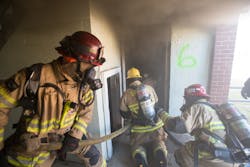Admit it. You’ve done it. Upon arrival at a working residential house fire, in the middle of a workday, with no vehicles in the driveway or reports of anyone inside, you made a rapid entry anyway. Later, while in rehab, when asked why you entered an immediately dangerous to life and health atmosphere without the support of a rapid-intervention team, you confidentially replied, “I thought I heard something and that maybe someone was in there.” There even is tongue-in-cheek rumors of aggressive fire companies that carry tricycles in their apparatus compartment to throw on the front lawn as they stretch their first line to justify an aggressive attack: “A child might be in there!”
As firefighters, we are forced to make split-second decisions by which lives hang in the balance. We are taught scene size-up, risk analysis, survivability profiles and other equations for our decision-making fire protection formulas to determine whether it’s safe to make an interior push on a working fire; but when the “maybe” factor enters the equation, suddenly there is no risk, obstacle or challenge that’s too great. The solution always is the same: “Go!”
Although there are some fireground decisions that are just plain reckless, there still is no doubt that the “maybe” factor has a wide latitude of acceptance in our circles. I challenge that the line between a reckless decision and a calculated one lies within the intent of those who are making it and their decision-making history. If the “maybe” factor is applied in a high-risk situation under the justification of saving a life, then that same “maybe” factor also should apply to all fire protection decisions that are made by those individuals.
For example, days before an election, a politician who historically voted to increase taxes who suddenly states that he/she is against tax hikes isn’t likely to be seen as authentic. The same applies to the fire service. If the “maybe” factor only is used on the emergency scene to justify risking your life and that of your company, but it hasn’t been a consistent factor in all of your historical decisions—from training, to physical exercise, to community risk reduction activities—should it be considered an authentic one?
Hackensack, 1988
The “maybe” equation is powerful, and when it has been applied it has saved countless lives. However, its selective underuse also has cost countless lives. If you truly believe “Everyone goes home,” then the “maybe” factor should be applied consistently in your fire protection formula. To illustrate, let’s apply the “maybe” factor to an historical incident: On July 1, 1988, in Hackensack, NJ, in a heavily analyzed line-of-duty-death (LODD) event, five firefighters were lost when a bowstring truss roof collapsed during fireground operations at an automobile dealership.
According to the New Jersey Bureau of Fire Safety, the cause of the fire is unknown, but the fire is believed to have been caused by a malfunctioning exhaust fan. Nine minutes after an employee extinguished a flaming piece of exhaust hose on the first floor, the fire was discovered in an attic where combustible materials were stored, in violation of the fire code.
At least one account notes that the incident commander (IC) on scene surveyed the roof and believed that it was a steel truss roof. According to the fire investigation report, delays in reaching the seat of the fire possibly were caused by storage in a stairway (also a violation of fire code) and/or a locked door.
At the time of the fire, the Hackensack Fire Department recently created a Fire Prevention Bureau that was responsible, per the municipal fire code, for conducting annual fire inspections; however, records showed that no inspection was conducted at the dealership. At least one article about the incident indicates that no firefighters had formal training on building construction.
Let’s apply the “maybe” factor to this tragedy. Relating to suppression operations at this fire, the “maybe” factor is obvious: Maybe they could extinguish it; maybe an employee was trapped; maybe the business was savable. However, for this “maybe” factor to be authentic, it must be applied to the whole fire protection equation.
“Maybe” if the annual inspection of the dealership occurred, then “maybe” the storage of combustibles in the attic would have been discovered, requiring a sprinkler system or a secondary means of access into the attic from the outside as code required. Then, “maybe” the fire would have been extinguished or contained by that sprinkler system. “Maybe” the department then would have received earlier notification. “Maybe” crews could have accessed the seat of the fire from outside and not underneath the bowstring truss roof.
“Maybe” if firefighters were educated on building construction and basic fire protection they would have been more aware of the dangers and made different decisions. “Maybe” if companies performed walkthroughs of buildings in their district, “maybe” they would have noticed a recent renovation, triggering a fire inspection and a sprinkler system. “Maybe” they would have seen the storage in the stairwell and removed it, permitting quicker access to the seat of the fire. “Maybe” if there was formal training in building construction and preplans regarding commercial structures, the IC would have known the roof wasn’t steel truss and might have made different decisions.
A combined perspective
There are more “maybes” to saving lives and property in the prevention equation than there are in the suppression equation. When you then factor in the level of risk as it applies to each, the prevention side demonstrates the best formula for saving lives. However, the point of this column isn’t choosing one formula over another but combining both into the whole fire protection package, thereby increasing the number of lives that can be saved, from the civilians who count on us to those who ride on the apparatus with us, and increasing the odds that “Everyone goes home.” Sadly, as we study many LODD reports and apply this same “maybe” factor to that fire protection equation, we see so many missed opportunities to save lives. That is unacceptable.
As we look at our community, we should see hundreds of “maybe” factors to figure into our equation. “Maybe” your crew will be exposed to fire and risk in the home of that family who visited your station, because a common fire hazard went unnoticed from a lack of education. “Maybe” the corner business has a fire hazard that will become an LODD incident, because it has gone unnoticed. “Maybe” that child who you hoisted into the driver’s seat of your apparatus will be the next fire statistic because of no smoke alarms or education on how to react to them. “Maybe.” And that should be enough for us to “go” and take corrective action.
Our communities rely on us to provide fire protection and keep them safe. Waiting for the alarm and hoping we “maybe” get there in enough time, and then hoping that we “maybe” go home after, isn’t a successful formula for anyone in our business because by then...it “maybe” to late.
About the Author

Daniel Byrne
DANIEL BYRNE is a community support officer for the Burton Fire District, Beaufort County, SC, and a retired assistant fire chief of training for the Georgia Air National Guard 165th Fire Department. A third-generation firefighter, he holds an associate degree and a bachelor’s degree in fire science as well as a master’s degree in public administration and disaster management. Byrne is an alumnus of the National Fire Academy. He received state and local awards for public relations and educational programs as well as community partnerships and served as a conference presenter and keynote speaker.
